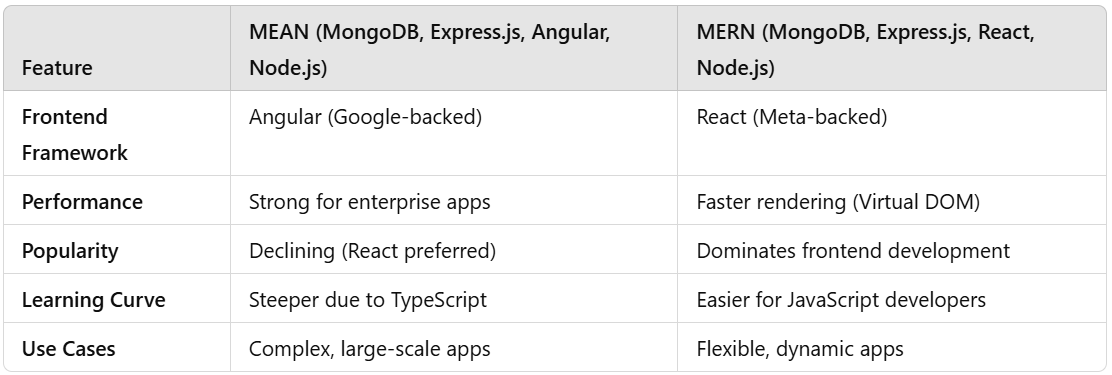The Future of Full-Stack Development: Will the MEAN/MERN Stack Still Dominate?
Is Full-Stack Development Evolving Beyond MEAN/MERN?
Full-stack development has changed dramatically in the last decade. The MEAN (MongoDB, Express.js, Angular, Node.js) and MERN (MongoDB, Express.js, React, Node.js) stacks have long been the go-to choices for building scalable, modern web applications.
But with AI-driven development, cloud-native applications, and new frameworks emerging, developers and companies alike are asking:
❓ Will MEAN and MERN continue to dominate?
❓ Are there better alternatives in 2025?
❓ What should businesses consider when hiring full-stack developers?
At Remoteplatz, we specialize in helping companies find, vet, and hire top-tier full-stack developers who work remotely. Whether you need MEAN/MERN experts or developers skilled in newer stacks, we make hiring seamless.
1. Why MEAN/MERN Became the Go-To Full-Stack Choice
MEAN and MERN became dominant because they offer:
✅ JavaScript across the stack → Frontend + Backend in the same language
✅ High scalability → Great for cloud-based applications
✅ Strong community support → Backed by Google (Angular) and Facebook (React)
✅ Speed and flexibility → Ideal for MVPs and startups
1.1 MEAN vs. MERN: A Quick Recap

🚀 Looking for top MEAN/MERN developers? Remoteplatz connects you with pre-vetted full-stack engineers.
2. Emerging Competitors: What’s Challenging MEAN/MERN in 2025?
While MEAN and MERN remain popular, new stacks and frameworks are gaining traction.
2.1 JAMstack (JavaScript, APIs, Markup)
JAMstack separates frontend and backend, improving performance, security, and scalability.
✅ Faster load times (Pre-rendered static content)
✅ Better security (No traditional backend)
✅ Popular tools: Next.js, Gatsby, Netlify
2.2 Serverless & Cloud-Native Stacks
With AWS Lambda, Google Cloud Functions, and Azure Functions, developers can skip managing servers.
✅ Lower costs (Pay-as-you-go pricing)
✅ Auto-scaling (Handles traffic spikes easily)
✅ Best for: Scalable microservices & real-time applications
2.3 Deno & Bun: The Successors to Node.js?
Node.js has ruled backend development, but Deno and Bun offer:
✅ Better security (No need for npm, built-in permissions)
✅ Faster performance (Optimized runtime)
✅ Support for TypeScript out of the box
📌 Will companies shift from MEAN/MERN to these alternatives? Hiring the right developers will be key.
🚀 Remoteplatz helps businesses find full-stack developers who adapt to emerging technologies.
3. Should Companies Still Hire MEAN/MERN Developers in 2025?
3.1 When MEAN/MERN is Still the Best Choice
Despite emerging alternatives, MEAN and MERN are still strong contenders for:
✔ Enterprise Applications (Banks, e-commerce, healthcare)
✔ MVP Development (Startups looking for quick iterations)
✔ Full-Stack JavaScript Teams (Faster onboarding for developers)
📊 Data-backed insight: According to the 2024 Stack Overflow Developer Survey, React remains the most used frontend framework (45% of developers), while Node.js continues to dominate backend development.
3.2 When to Consider Other Stacks
❌ For high-performance applications: Use Rust, Go, or Elixir
❌ For static websites & blogs: JAMstack (Next.js, Gatsby)
❌ For cloud-native scalability: Serverless & edge computing
🚀 Need MEAN/MERN experts or developers skilled in modern stacks? Remoteplatz makes hiring easy.
4. How to Hire the Best Full-Stack Developers in 2025
4.1 Why Traditional Hiring Methods Fail
🚫 Posting on job boards = Slow & ineffective
🚫 Too many unqualified applicants
🚫 Time-consuming screening process
4.2 The Remoteplatz Advantage: Fast, Reliable Hiring
🔹 Pre-vetted developers → Only the top 3% pass our screening
🔹 Match in days, not weeks → Get the right fit quickly
🔹 Flexible hiring → Full-time, freelance, or contract-based
🚀 Want to build a strong full-stack team? Join Remoteplatz and hire with confidence.
5. The Future of Full-Stack Development: What’s Next?
5.1 AI-Assisted Development
With GitHub Copilot and AI-powered testing, AI is making coding faster. But does that mean junior developers are at risk? (Spoiler: No, but they need to upskill!)
5.2 More Focus on Performance & Security
Expect a shift towards WebAssembly, Rust, and AI-enhanced security as apps handle more data-sensitive workloads.
5.3 Hybrid Stacks Over Monolithic Stacks
Companies are mixing technologies (e.g., React frontend with a Python backend) instead of sticking to one stack.
🚀 Want developers who stay ahead of trends? Remoteplatz connects you with the best.
FAQs: Optimized for Featured Snippets
1. Is MERN still relevant in 2025?
Yes! React remains one of the most popular frontend frameworks, and Node.js is widely used for backend development.
2. What are the alternatives to the MEAN/MERN stack?
JAMstack, serverless architectures, and new runtimes like Deno and Bun are gaining popularity.
3. How do I hire top full-stack developers?
Use specialized hiring platforms like Remoteplatz to find pre-vetted remote engineers quickly.
4. Should my company switch from MEAN/MERN?
It depends on your use case. If you need scalability, AI integration, or cloud-native apps, consider modern alternatives.
5. Where can I find the best full-stack developers?
🚀 Remoteplatz offers a curated network of skilled full-stack engineers.
🔗 Hire Remote Full-Stack Developers Today
Final Thoughts: Will MEAN/MERN Survive?
✅ MEAN/MERN is still powerful, but companies are exploring new full-stack approaches.
✅ Hiring developers who stay ahead of trends is key.
✅ Remoteplatz helps businesses find the right talent—fast.
